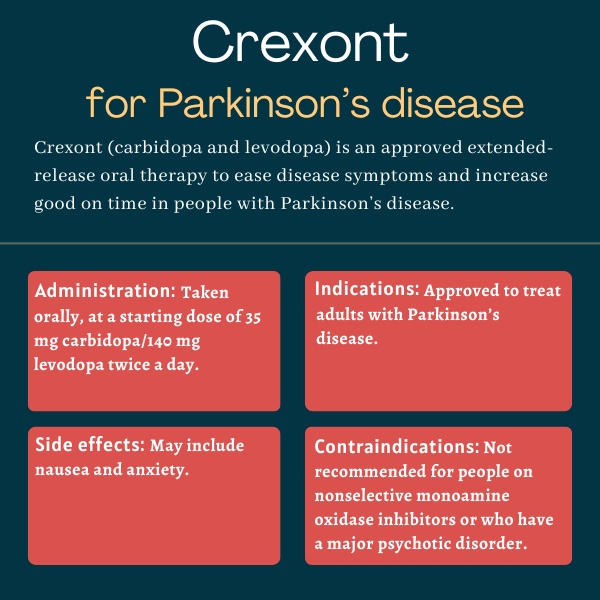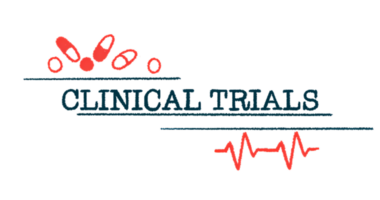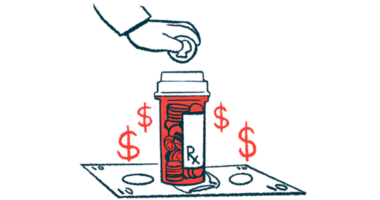Crexont (carbidopa and levodopa) for Parkinson’s disease
Last updated Aug. 12, 2024, by Marta Figueiredo, PhD

What is Crexont for Parkinson’s disease?
Crexont is an extended-release oral formulation of carbidopa and levodopa that’s approved in the U.S. to help ease symptoms in people with Parkinson’s disease.
Crexont is designed to maintain steady levels of carbidopa and levodopa in the body. Its formulation allows it to be better absorbed and extends the periods of optimal symptom management, known as good on time, while requiring fewer daily doses.
Formerly known as IPX203, the therapy was developed by Impax Laboratories, which is now part of Amneal Pharmaceuticals.
Therapy snapshot
| Brand name: | Crexont |
| Chemical name: | Carbidopa and levodopa |
| Usage: | Used to treat Parkinson’s disease; can increase the periods when symptoms are adequately controlled |
| Administration: | Extended-release oral capsules |
How does Crexont work?
Parkinson’s is caused by the progressive death of nerve cells that produce dopamine, a major brain signaling molecule involved in controlling voluntary movement. Since dopamine can’t be directly administered to patients, therapies based on levodopa, its precursor, are a mainstay of Parkinson’s treatment.
While this type of therapy is intended to increase dopamine in Parkinson’s patients, a variable dosage may reach the brain with traditional levodopa tablets, due to varying amounts of it being absorbed in the digestive system.
Levodopa is usually given in combination with carbidopa, which prevents it from being converted into dopamine before it reaches the brain. This way, more levodopa is available to make dopamine, allowing patients to receive lower levodopa doses and have fewer side effects.
Levodopa-based treatments often become less effective over time, leading to off episodes when the treatment effects wear off between doses and symptoms return.
Immediate-release carbidopa/levodopa oral tablets also typically require frequent doses, with their concentrations often fluctuating over time while patients are receiving treatment.
As a result, dopamine receptors in the brain are stimulated intermittently. Researchers believe this explains why patients using levodopa for prolonged periods often have motor complications, such as dyskinesia, or uncontrolled, involuntary movements.
Crexont is an extended-release oral formulation of carbidopa/levodopa designed to maintain steady levels of the molecules in the body and improve absorption efficacy. It contains both immediate-release granules of carbidopa and levodopa in a 1-to-4 ratio — similar to marketed combinations — and extended-release beads of levodopa alone.
Previous data indicated carbidopa’s availability in the body would be greater if its content was in an immediate-release formulation. The levodopa beads are coated with specific molecules that allow its slow release, prevent its early disintegration in the stomach, and boost its absorption in the intestinal area where it’s effectively absorbed.
Crexont’s innovative formulation is designed to provide immediate delivery of 25% of the levodopa dose, causing a quick rise in levodopa levels, followed by a steady release of the remaining 75% for a longer period relative to currently available products, including Amneal’s other carbidopa/levodopa extended-release capsule called Rytary. Crexont is expected to be better absorbed and have longer lasting effects, thereby increasing the periods with good symptom control, with fewer daily doses.
Who can take Crexont?
Crexont was approved by the U.S. Food and Drug Administration in August 2024 for the treatment of adults with Parkinson’s disease.
That approval also included two other indications: post-encephalitic parkinsonism (Parkinson’s-like symptoms that develop after brain inflammation) and parkinsonism that may occur due to carbon monoxide or manganese intoxication.
Who should not take Crexont?
Crexont is contraindicated, or not recommended, for people who are using nonselective monoamine oxidase (MAO) inhibitors, a type of antidepressant medication, or who have taken MAO inhibitors within the previous two weeks. Combining these medications with Crexont can result in high blood pressure.
The medication also should not be administered to people with a major psychotic disorder due to a risk of psychosis exacerbation.
How is Crexont administered?
Crexont is available as extended-release capsules containing white to off-white granules and pellets that come in four strengths:
- The lowest-dose capsules contain 35 mg of carbidopa and 140 mg of levodopa. They are white and yellow and are imprinted with “140” on the body and “IPX203” on the cap.
- The second lowest dose are capsules containing 52.5 mg of carbidopa and 210 mg of levodopa. These are white and green and are imprinted with “210” on the body and “IPX203” on the cap.
- The third dose contains 70 mg of carbidopa and 280 mg of levodopa. Capsules are white and purple and are imprinted with “280” on the body and “IPX203” on the cap.
- The highest-dose capsules contain 87.5 mg of carbidopa and 350 mg of levodopa. They are white and orange and are imprinted with “350” on the body and “IPX203” on the cap.
For patients who have not previously taken levodopa, the recommended starting dose is 35 mg carbidopa/140 mg levodopa, taken orally twice a day for the first three days. After this initial period, the dosage can be gradually increased as needed, up to a maximum daily dosage of 525 mg carbidopa/2100 mg levodopa, divided into four doses per day.
For patients who are transitioning from immediate-release formulations of carbidopa and levodopa, the initial Crexont dosage is determined based on the daily levodopa dosage received during their previous treatment regimen. If more than one dose corresponds to the most frequent, the highest one should be used.
After one to three days of conversion to Crexont, dosage and frequency should be adjusted gradually based on individual clinical responses and tolerability, up to a maximum daily dosage of 525 mg carbidopa/2100 mg levodopa, divided into four doses per day.
If patients were previously receiving a carbidopa and levodopa treatment with a COMT inhibitor, a combination that increases the amount of levodopa reaching the brain, they may need to increase their initial total daily levodopa dose if the COMT inhibitor is stopped when switching to Crexont.
When converting from Rytary to Crexont, patients should start with a dosage based on a 1:1 mg conversion, using the levodopa component for conversion.
Crexont capsules should be swallowed whole and not chewed, divided, or crushed. They can be taken with or without food, although consuming a meal high in fat and calories can delay the absorption of levodopa. Capsules should not be taken with alcohol.
To prevent potential adverse effects, patients should not abruptly stop or rapidly decrease their daily dose of Crexont. Instead, daily dosages should be gradually tapered when discontinuing treatment.

Crexont in clinical trials
Crexont’s approval was mainly based on results from Phase 2 and Phase 3 clinical trials comparing Crexont with other formulations of carbidopa and levodopa in people with advanced Parkinson’s and having off periods.
IPX203-B14-02
A Phase 2 trial, dubbed IPX203-B14-02 (NCT02271503), investigated the single-dose pharmacological properties of Crexont against Sinemet — immediate-release carbidopa/levodopa tablets — and Rytary extended-release capsules.
The study included 26 Parkinson’s patients with two or more hours of daily off time while on stable levodopa-based treatment. All received a single dose of each of the treatments separated by about one week. The order of the treatments was randomly assigned for each patient.
Blood levodopa levels increased rapidly and similarly across all three treatments, results showed. However, levodopa was maintained at more than half its highest concentration for longer with Crexont (4.7 hours) than with Sinemet (1.9 hours) or Rytary (3.9 hours).
Longer effects were also observed with the therapy for motor improvements, as assessed with part three of the Movement Disorder Society-Unified Parkinson’s Disease Rating Scale (MDS-UPDRS).
Also, Crexont resulted in a significant reduction in daily off time relative to immediate-release tablets (by 2.7 hours) and Rytary (by 0.9 hours), based on investigator assessments. This off time was generally converted into hours of good on time without troublesome dyskinesia.
IPX203-B16-01
The U.S.-based Phase 2 IPX203-B16-01 trial (NCT03007888) tested single and multiple doses of Crexont versus Sinemet in 28 adults with advanced Parkinson’s. Despite being on a stable carbidopa/levodopa regimen, all were waking up in an off state most mornings, were having at least two hours a day of off time during waking hours, and had motor complications such as dyskinesia.
Participants were randomly assigned to receive either a two-week daily treatment with Sinemet followed by a two-week daily treatment with Crexont, or vice versa. Treatment periods were separated by a one-week “washout” period, where patients only took their prestudy Parkinson’s medication regimen.
Data showed comparable initial increases in levodopa concentrations, but longer effects with Crexont, even though the therapy was taken less frequently (2 vs. 3.1 times a day).
According to patient diaries, Crexont resulted in a significantly lower percentage of off time during waking hours compared with Sinemet (19.3% vs. 33.5%), meeting the trial’s main goal. This translated into a 2.3-hour greater reduction in daily off time and a 1.9-hour increase in daily good on time with Crexont.
Motor improvements, as assessed with part three of the MDS-UPDRS, were significantly greater and lasted significantly longer with Crexont than Sinemet.
RISE-PD trial
The Phase 3 RISE-PD trial (NCT03670953) enrolled 506 adults with Parkinson’s with off periods at sites in the U.S. and Europe.
Participants underwent a dose-adjustment period with a generic of Sinemet for the first three weeks followed by four weeks wherein they switched to Crexont. Patients were then randomly assigned to either Crexont (with matching Sinemet generic placebo tablets) or a Sinemet generic (with matching Crexont placebo capsules) for 13 weeks (about three months). The dosage and frequency were tailored to each patient.
RISE-PD’s main goal was to assess changes in daily good on hours between weeks seven and 20.
Results showed Crexont-treated patients had 0.53 more hours of good on time a day and 0.48 fewer hours of daily off periods than those on immediate-release tablets. Further analyses showed that the therapy increased good on time per dose by a mean of 1.55 hours relative to immediate-release tablets.
Also, a significantly greater proportion of Crexont-treated patients reported that their condition “much” or “very much” improved compared with those in the Sinemet generic group (29.7% vs. 18.8%).
Crexont’s superiority over immediate-release tablets was seen despite its less frequent dosing (mean of three vs. five times per day).
No significant group differences were observed regarding changes in Parkinson’s motor and overall symptoms, as assessed with the MDS-UPDRS.
Extension study
After completing the RISE-PD study, 419 participants chose to enroll in an open-label extension trial (NCT03877510) where all received Crexont for nine months.
Results showed that the therapy remained safe and effective throughout the extension study and was associated with a sustained control of symptoms. The dosing frequency was stable over the study period, with a mean of about three doses a day.
Common side effects of Crexont
The most common side effects reported with Crexont in clinical trials include nausea and anxiety.
Falling asleep during daily activities
There have been reports of people falling asleep during daily activities while on levodopa-based therapies. Before starting treatment with Crexont, it is important to evaluate and discuss with the healthcare provider any factors that may contribute to increased sleepiness, including sleep disorders and other medications that can cause sedation.
Discontinuing treatment should be considered in cases of severe daytime sleepiness or instances of falling asleep during daily activities. If patients decide to continue on the therapy, driving and other activities where sudden, unexpected sleep episodes may pose a risk should be avoided.
High fever and confusion associated with rapid dose reductions
After rapid dose reductions or discontinuation of dopaminergic therapy, patients may experience symptoms such as high fever, stiff muscles, changes in breathing and heartbeat, and confusion. To minimize those risks, patients who decide to discontinue treatment should be closely monitored and their Crexont dosage should be gradually tapered.
Cardiovascular events
Crexont has been associated with cardiovascular events, particularly in people with a history or risk factors for heart disease. For that reason, patients with a history of heart attack who continue to have irregular heartbeats should have their cardiac function monitored in an intensive cardiac care setting during the initial period of Crexont dosage adjustment.
Hallucinations, psychosis, and impulse control
Treatment with Crexont may lead to hallucinations (seeing or hearing things that are not real), psychosis, and impulse control issues, including gambling, overeating, and increased sexual urges.
Patients with a major psychotic disorder should not take Crexont, as it may worsen their symptoms. If patients experience impulse control disorders, a reduction in dosage or stopping the treatment should be considered.
Dyskinesia
Treatment with Crexont may lead to dyskinesia, or uncontrolled, involuntary muscle movements. If this occurs, patients may need to reduce the dosage of either Crexont or other Parkinson’s medications.
Stomach and eye issues
Crexont may increase the risk of gastrointestinal bleeding in patients who have a history of stomach ulcers. It may also raise the pressure inside the eye in patients with glaucoma, a condition where pressure in the eye is higher than normal and damages the optic nerve. Eye pressure should be checked regularly in people with glaucoma to prevent possible vision problems after initiating treatment with Crexont.
Use in pregnancy and breastfeeding
There are no adequate data on the use of Crexont in pregnant or breastfeeding individuals. Animal studies suggest that the therapy might harm a developing fetus, and thus Crexont should only be used during pregnancy if the potential benefits outweigh the potential risks to the fetus.
Because levodopa has been detected in breast milk, it is essential to exercise caution when considering Crexont for nursing patients.
Patients who are or plan to become pregnant, or are nursing or plan to breastfeed, should discuss the risks and benefits with their healthcare providers.
Parkinson’s News Today is strictly a news and information website about the disease. It does not provide medical advice, diagnosis, or treatment. This content is not intended to be a substitute for professional medical advice, diagnosis, or treatment. Always seek the advice of your physician or other qualified health provider with any questions you may have regarding a medical condition. Never disregard professional medical advice or delay in seeking it because of something you have read on this website.
Recent Posts
- Understanding the importance of advance directives
- New study reveals why exercise is vital for Parkinson’s brain health
- GT-02287 boosts enzyme activity in Parkinson’s brain: Trial data
- Dealing with scrutiny when symptoms of Parkinson’s are invisible
- Grant backs new imaging approach for earlier Parkinson’s detection
Related articles






